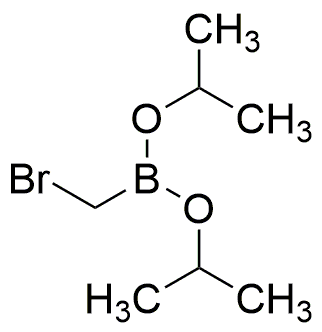Diisopropyl (bromomethyl)boronate is widely utilized in research focused on:
- Organic Synthesis: This compound serves as a versatile reagent in the synthesis of various organic molecules, particularly in the formation of carbon-boron bonds, which are crucial for building complex structures in pharmaceuticals and agrochemicals.
- Medicinal Chemistry: It plays a significant role in drug development, allowing researchers to create boron-containing compounds that can enhance the efficacy of therapeutic agents, particularly in cancer treatment.
- Material Science: The compound is used in the development of advanced materials, including polymers and coatings, where its unique properties can improve durability and performance.
- Cross-Coupling Reactions: It is employed in cross-coupling reactions, which are essential for forming carbon-carbon bonds, thus facilitating the creation of complex organic molecules in a more efficient manner compared to traditional methods.
- Research and Development: This chemical is valuable in academic and industrial research settings for exploring new synthetic pathways and improving existing methodologies, making it a preferred choice for researchers looking to innovate.
General Information
Properties
Safety and Regulations
Applications
Diisopropyl (bromomethyl)boronate is widely utilized in research focused on:
- Organic Synthesis: This compound serves as a versatile reagent in the synthesis of various organic molecules, particularly in the formation of carbon-boron bonds, which are crucial for building complex structures in pharmaceuticals and agrochemicals.
- Medicinal Chemistry: It plays a significant role in drug development, allowing researchers to create boron-containing compounds that can enhance the efficacy of therapeutic agents, particularly in cancer treatment.
- Material Science: The compound is used in the development of advanced materials, including polymers and coatings, where its unique properties can improve durability and performance.
- Cross-Coupling Reactions: It is employed in cross-coupling reactions, which are essential for forming carbon-carbon bonds, thus facilitating the creation of complex organic molecules in a more efficient manner compared to traditional methods.
- Research and Development: This chemical is valuable in academic and industrial research settings for exploring new synthetic pathways and improving existing methodologies, making it a preferred choice for researchers looking to innovate.
Documents
Safety Data Sheets (SDS)
The SDS provides comprehensive safety information on handling, storage, and disposal of the product.
Product Specification (PS)
The PS provides a comprehensive breakdown of the product’s properties, including chemical composition, physical state, purity, and storage requirements. It also details acceptable quality ranges and the product's intended applications.
Certificates of Analysis (COA)
Search for Certificates of Analysis (COA) by entering the products Lot Number. Lot and Batch Numbers can be found on a product’s label following the words ‘Lot’ or ‘Batch’.
Número de catálogo
Número de lote/lote
Certificates Of Origin (COO)
This COO confirms the country where the product was manufactured, and also details the materials and components used in it and whether it is derived from natural, synthetic, or other specific sources. This certificate may be required for customs, trade, and regulatory compliance.
Número de catálogo
Número de lote/lote
Safety Data Sheets (SDS)
The SDS provides comprehensive safety information on handling, storage, and disposal of the product.
DownloadProduct Specification (PS)
The PS provides a comprehensive breakdown of the product’s properties, including chemical composition, physical state, purity, and storage requirements. It also details acceptable quality ranges and the product's intended applications.
DownloadCertificates of Analysis (COA)
Search for Certificates of Analysis (COA) by entering the products Lot Number. Lot and Batch Numbers can be found on a product’s label following the words ‘Lot’ or ‘Batch’.
Número de catálogo
Número de lote/lote
Certificates Of Origin (COO)
This COO confirms the country where the product was manufactured, and also details the materials and components used in it and whether it is derived from natural, synthetic, or other specific sources. This certificate may be required for customs, trade, and regulatory compliance.


